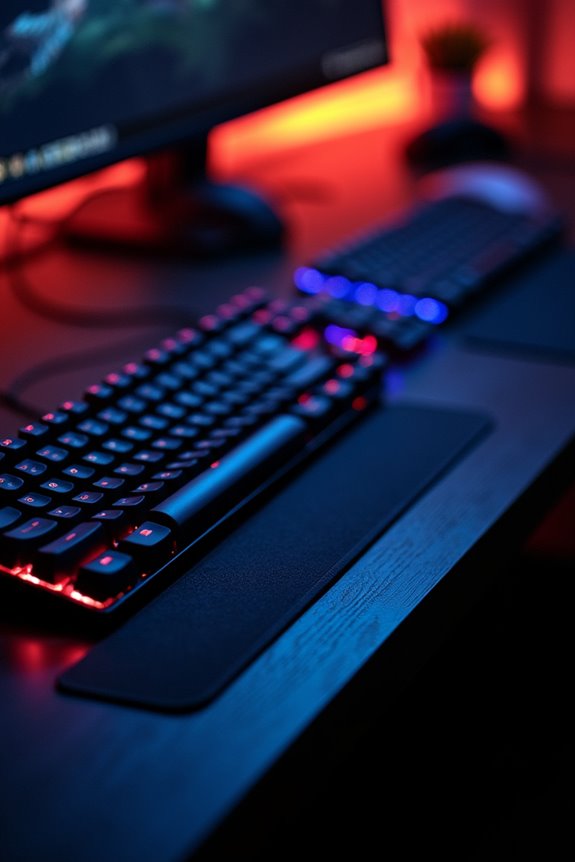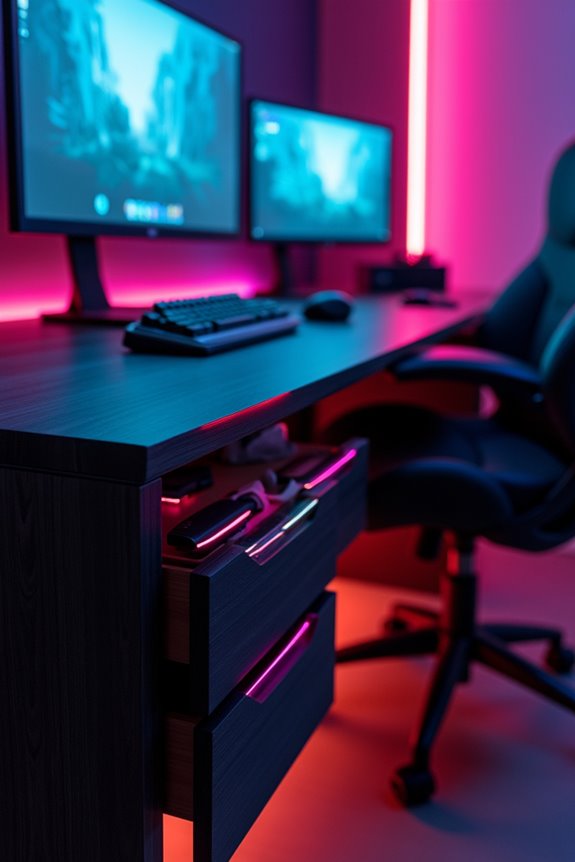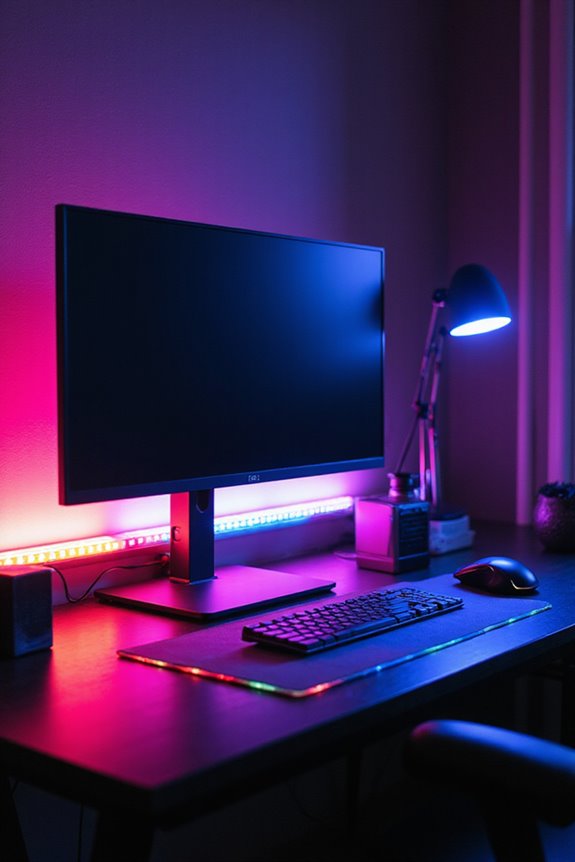As an Amazon Associate, we earn from qualifying purchases. Some links may be affiliate links at no extra cost to you. Although our opinions are based on curated research, we haven't used these products. Articles generated with AI.
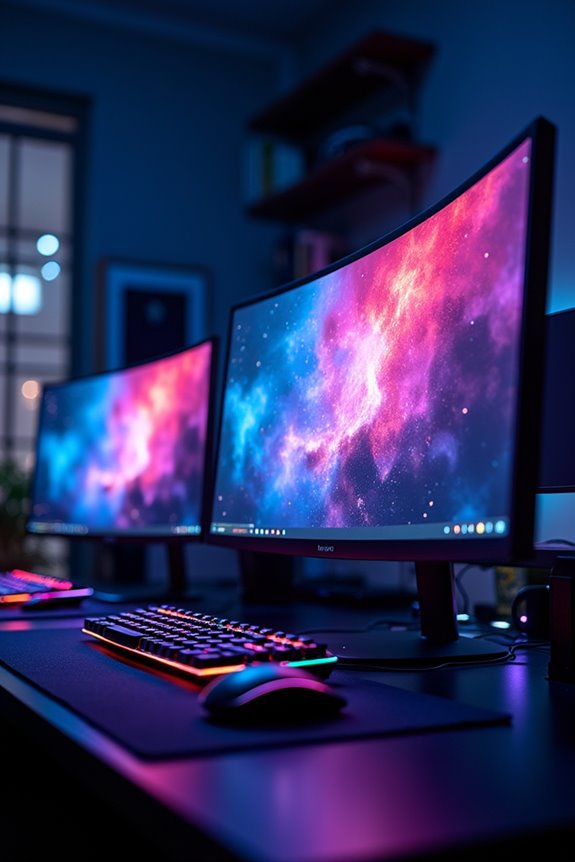
The 3 Best Gaming Monitors With Low Input Lag for Ultimate Performance
For gamers seeking low input lag and stellar performance, check out the SANSUI 27 inch Curved Monitor (ES-27C1) for its 100Hz refresh rate and 1ms response time. The KOORUI 24″ Gaming Monitor (G2411P) shines with a 200Hz refresh rate, delivering vibrant visuals. Finally, the Raywego 27 inch option, with a Full HD resolution and built-in speakers, offers great value. With these choices, you’ll experience smooth gameplay and vivid colors. But there’s more to evaluate!
Key Takeaways
- SANSUI 27 inch Curved Monitor offers a 100Hz refresh rate and 1ms response time, ensuring smooth gameplay and low input lag for budget gamers.
- KOORUI 24″ Gaming Monitor features a 200Hz refresh rate and 1ms response time, providing an enhanced gaming experience with vibrant visuals.
- Raywego 27 inch Gaming Monitor has a 100Hz refresh rate and 3ms response time, delivering solid performance with occasional reports of screen issues.
- Look for monitors with advanced features like Adaptive Sync and high refresh rates to minimize input lag and improve gameplay.
- Eye comfort technologies such as blue light filters and flicker-free technology enhance long gaming sessions while maintaining focus and minimizing eye strain.
SANSUI 27 inch Curved Monitor (ES-27C1)
Sale
SANSUI Curved Monitor 27 inch 120Hz USB Type-C Computer Monitor with Speakers Built in丨FHD...
- ⭐27 inch curved monitor with speakers built in for gaming, work or business.
- Screen Feature: 120hz Refresh Rate丨1ms(MPRT) Fast Response Time丨Adaptive Sync
- Display Color: 110% sRGB丨 4000:1 Contrast Ratio丨300Nits Brightness丨16.7M display colors
If you’re on the hunt for a gaming monitor that blends performance with affordability, the SANSUI 27 inch Curved Monitor (ES-27C1) might just be your best bet. With a 100Hz refresh rate and a lightning-fast 1ms response time, you’ll enjoy smooth gameplay without lag. Its vibrant 110% sRGB color coverage and 4000:1 contrast ratio make visuals pop, while the 300 nits brightness guarantees clarity in various lighting conditions.
However, some users reported needing to tweak brightness settings for peak viewing. Overall, it’s a solid choice for budget-conscious gamers looking for quality performance.
PROS
- High refresh rate and response time
- Excellent color accuracy
- Affordable price
CONS
- Brightness may need adjustment
- Initial color/sharpness tweaks required
Best For: Budget-conscious gamers looking for a high-performance monitor that delivers smooth gameplay and vibrant visuals.
Pros:
- High refresh rate and response time
- Excellent color accuracy
- Affordable price
Cons:
- Brightness may need adjustment
- Initial color/sharpness tweaks required
KOORUI 24″ Gaming Monitor (G2411P)
Sale
KOORUI 24" Gaming Monitor, 200Hz 1ms Fast IPS, FHD HDR400 Display, 90% DCI-P3 Color Gamut, Adaptive...
- Smooth & EyeCare Comfort: 200Hz refresh rate with Smart Adaptive Sync eliminates screen tearing, while 1080p resolution optimizes GPU performance for up to 30% higher...
- Fast IPS Visual Dominance: The monitor with a new-generation fast IPS panel provides ultra-wide view, vibrant colors, smooth gradients for gaming & Pro design. Say...
- Ergonomic Gaming & Working Station : This gaming monitor combines modern design with an ultra-thin body and an ergonomic stand that tilts -5° to 20°. The quick-assembly...
For gamers seeking a blend of performance and affordability, the KOORUI 24″ Gaming Monitor (G2411P) stands out with its impressive 200Hz refresh rate and 1ms response time. This fast IPS panel delivers vibrant colors and smooth gradients, ensuring immersive gameplay. With a 90% DCI-P3 color gamut, you’ll enjoy over 16.7 million lifelike colors, making every game visually stunning.
However, some users report mixed experiences with customer support. But with a 3-year spare parts warranty and VESA mount compatibility, it’s a solid choice for budget-conscious gamers.
PROS:
- High refresh rate and response time
- Wide color gamut
CONS:
– Mixed customer support feedback
Best For: Budget-conscious gamers looking for high performance and vibrant visuals in their gameplay experience.
Pros:
- High refresh rate and response time for smooth gameplay.
- Wide color gamut providing over 16.7 million lifelike colors.
- Ergonomic design with tilt adjustments and VESA mount compatibility.
Cons:
- Mixed customer support feedback reported by users.
- Potential reliability concerns based on customer experiences.
- May require additional investment for higher-end monitors if reliability is a priority.
27 inch Gaming Monitor 100Hz Full HD with Built-in Speakers
Sale
Raywego 27 inch Gaming Monitor 100Hz Computer Monitor Built-in Speakers Full HD 1920 x 1080P with...
- 【 𝗕𝘂𝗶𝗹𝘁-𝗶𝗻 𝗦𝗽𝗲𝗮𝗸𝗲𝗿𝘀 】 The Raywego 27-inch low blue light display features a unique built-in audio design. Whether you are...
- 【𝗦𝘁𝘂𝗻𝗻𝗶𝗻𝗴 𝗩𝗶𝘀𝘂𝗮𝗹𝘀 𝗳𝗼𝗿 𝗪𝗼𝗿𝗸 & 𝗣𝗹𝗮𝘆】The smooth 100Hz can make your work run more smoothly,...
- 【𝗦𝗺𝗼𝗼𝘁𝗵 & 𝗘𝘆𝗲-𝗙𝗿𝗶𝗲𝗻𝗱𝗹𝘆 𝗔𝗰𝘁𝗶𝗼𝗻】The unique low blue light mode and flicker-free technology,...
When you need a gaming monitor that delivers exceptional performance without breaking the bank, the Raywego 27 inch Gaming Monitor stands out as a top choice. With a Full HD resolution of 1920 x 1080 pixels and a 100Hz refresh rate, it guarantees smooth gameplay, while the 3ms response time helps eliminate ghosting. The monitor’s brightness of 300 Nits and a contrast ratio of 3000:1 provides vibrant visuals.
Plus, built-in speakers mean you won’t need extra audio equipment. However, some users report issues with stickers on the screen. Overall, it’s a solid option for gamers on a budget.
PROS:
- 100Hz refresh rate for smooth motion
- Built-in speakers
- Eye care technology features
CONS:
- Occasional power issues reported
- Stickers on the screen can be annoying
Best For: Gamers seeking an affordable monitor that offers smooth performance and built-in audio capabilities.
Pros:
- 100Hz refresh rate for smooth motion
- Built-in speakers for convenient audio
- Eye care technology features to reduce eye strain
Cons:
- Occasional power issues reported
- Stickers on the screen can be annoying
Factors to Consider When Choosing a Gaming Monitor With Low Input Lag
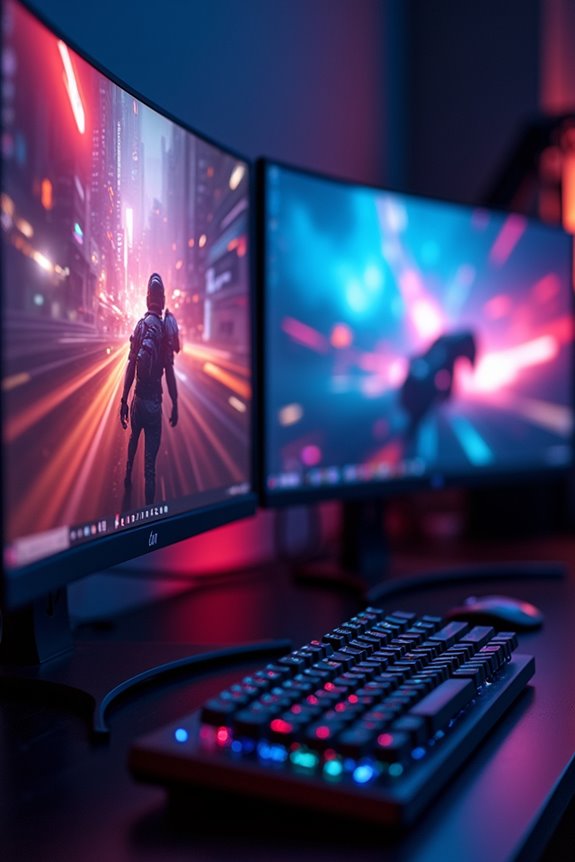
When picking a gaming monitor with low input lag, you’ve got to take into account several key factors. Refresh rate and response time play vital roles in your gaming experience, while the type of display technology can affect both visuals and performance. Don’t forget about connectivity options and ergonomic design—both can enhance your overall setup and comfort during those long gaming sessions.
Refresh Rate Importance
Understanding refresh rates is essential for anyone looking to select a gaming monitor with low input lag. A higher refresh rate, like 100Hz or 200Hz, offers smoother motion and reduces motion blur, enhancing your gaming experience. Monitors exceeding 60Hz can considerably lower input lag, making gameplay feel more responsive during fast-paced moments.
Additionally, refresh rates that match your graphics card’s frame rates help prevent screen tearing, resulting in improved visual fluidity. When combined with low response times (1ms to 3ms), these higher refresh rates guarantee quick pixel shifts for fast-moving images. Plus, adaptive sync technologies can dynamically adjust refresh rates, further minimizing lag and providing a smoother gaming experience. So, keep refresh rates in mind when making your choice!
Response Time Matters
Response time plays a pivotal role in your gaming experience, as it directly impacts how quickly a monitor can render fast-moving images. A response time of 1ms is ideal for competitive gaming, minimizing motion blur and ghosting effects. Monitors with 1ms or 3ms response times enhance clarity, giving you an edge during intense gameplay.
When combined with a 100Hz refresh rate, these low response times guarantee smoother motion and better synchronization with your graphics card. If you’re considering IPS panels for their color accuracy and viewing angles, opt for those with a response time of 5ms or lower to maintain gameplay fluidity. Remember, every millisecond counts when you’re in the heat of battle!
Display Technology Choices
Choosing the right display technology for your gaming monitor can be a game-changer, especially if you’re aiming for low input lag. IPS panels usually deliver better color accuracy and wider viewing angles while maintaining competitive response times. If you want smooth gameplay, look for monitors with a refresh rate of 100Hz or higher; they reduce input lag compared to standard 60Hz displays. A low response time, ideally between 1ms to 3ms, is essential for minimizing ghosting and blurring during action-packed scenes. Plus, features like AMD FreeSync or NVIDIA G-Sync help eliminate screen tearing and stuttering, which can enhance your gaming experience. Consider these factors carefully to optimize your setup for ultimate performance.
Connectivity Options Available
When it comes to selecting a gaming monitor, connectivity options play an essential role in achieving low input lag and an overall smooth gaming experience. Look for multiple ports like HDMI, DisplayPort, and USB Type-C to connect various devices effortlessly. Monitors with HDMI 2.0 or DisplayPort 1.4 support higher refresh rates and resolutions, which is important for minimizing lag.
Having multiple inputs allows easy switching between consoles or PCs without the hassle of unplugging. Plus, these ports often support Adaptive Sync technology, reducing screen tearing during intense gameplay. Make sure the monitor’s connectivity aligns with your gaming setup; you might need USB-A to HDMI adapters if your laptop has limited HDMI options.
Ergonomic Design Features
Ergonomic design features in gaming monitors aren’t just about aesthetics; they can greatly enhance your gaming experience. Look for adjustable tilt angles, typically ranging from -5° to 20°, which allow you to find that perfect viewing position for marathon sessions. Ultra-thin bezels and frameless designs maximize screen real estate, pulling you deeper into the action.
VESA mount compatibility, like the common 100 x 100mm, offers flexible installation, optimizing both comfort and aesthetics. Don’t overlook eye comfort technologies—blue light filters and flicker-free tech help reduce eye strain during those epic gaming nights. A stable stand adds to the stability, ensuring your monitor stays put during intense gameplay. Overall, these features balance comfort and performance beautifully.
Budget and Value
Budget plays a significant role in your choice of a gaming monitor with low input lag. Monitors can vary widely in price, affecting features like refresh rate and response time. While premium models often deliver lower input lag, you need to balance your budget with performance needs. Look for monitors that offer a high refresh rate (100Hz or more) and low response times (1ms to 3ms) to guarantee smooth gameplay without overspending. Investing a bit more can yield advanced features like Adaptive Sync and better color gamuts, enhancing your gaming experience. Consider long-term value; a reliable monitor may save you from frequent upgrades, especially if it includes added comforts like built-in speakers and ergonomic designs.
Frequently Asked Questions
What Is Input Lag and Why Is It Important for Gaming?
Input lag refers to the delay between your action and the corresponding response on screen. It’s vital for gaming because high input lag can hinder your reflexes, making competitive play frustrating. Ideally, you want input lag below 20 milliseconds for smooth gameplay. Lower input lag means quicker reactions, giving you an edge in fast-paced games. So, if you’re serious about gaming, a monitor with minimal input lag is a must-have for better performance.
How Do Refresh Rates Affect Gaming Performance?
Refresh rates can make or break your gaming experience. A higher refresh rate, like 144Hz, means smoother visuals and more responsive gameplay. You’ll notice less motion blur, which is essential for fast-paced games. However, if your graphics card can’t keep up, you won’t fully benefit. So, while a 240Hz monitor sounds great, make sure your setup can handle it. Ultimately, balancing refresh rates with your hardware is key for peak performance.
Can I Reduce Input Lag With Specific Settings?
Yes, you can reduce input lag with specific settings. Start by enabling Game Mode on your monitor, which optimizes performance. Lowering the resolution and turning off V-Sync can also help, but remember, these tweaks may affect visual quality. Adjusting your refresh rate to match your system’s output is key as well. Ultimately, using a wired connection instead of Wi-Fi can minimize latency. Every little bit counts in your gaming experience!
Are There Any Gaming Monitors Under $200 With Low Input Lag?
You can find several gaming monitors under $200 that boast low input lag. Look for models with a 1ms response time and a refresh rate of at least 60Hz. Brands like Acer and AOC often deliver solid options. Just remember, while they perform well for casual gaming, features like HDR and ultra-high refresh rates might be limited. So, weigh those factors based on your gaming style. Happy hunting!
How Does Panel Type Influence Input Lag?
Panel type greatly influences input lag, impacting your gaming experience. For instance, TN panels generally have lower input lag compared to IPS or VA panels, making them ideal for fast-paced games. However, IPS panels offer better color accuracy and viewing angles, which could be a trade-off for some. VA panels usually sit in the middle, balancing decent response times with good contrast. Ultimately, your choice should align with your gaming preferences and visual requirements.




